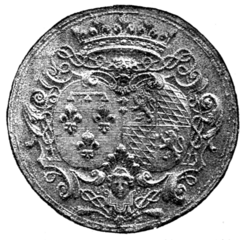compony label of azure and argent borne by their father, which indicated their descent from John of Gaunt. One of the best known English examples of differencing by a change of charges is that of the coat of the Cobhams, "Gules, a chevron or," in which the ordinary was charged by various cadets with three pierced estoiles, three lions, three crossed crosslets, three "fleurs-de-lis," three crescents, and three martlets, all of "sable."
The original Grey coat ["Barry of six argent and azure"] is differenced in the Roll of Edward I. by a bend gules for John de Grey; at Caerlaverock this is engrailed.
The Segrave coat ["Sable, a lion rampant argent"] is differenced by the addition of "a bendlet or"; or "a bendlet gules"; and the last is again differenced by engrailing it.
In the Calais Roll the arms of William de Warren ["Chequy or and azure"] are differenced by the addition of a canton said to be that of Fitzalan (but really that of Nerford).
Whilst no regular system of differencing has survived in France, and whilst outside the Royal Family arms in that country show comparatively few examples of difference marks, the system as regards the French Royal Arms was well observed and approximated closely to our own. The Dauphin of France bore the Royal Arms undifferenced but never alone, they being always quartered with the sovereign arms of his personal sovereignty of Dauphiné: "Or, a dolphin embowed azure, finned gules." This has been more fully referred to on page 254. It is much to be regretted that the arms of H.R.H. the Prince of Wales do not include the arms of his sovereignty of the Duchy of Cornwall, nor any allusion to his dignities of Prince of Wales or Earl of Chester.

Fig. 698.—Seal of Elizabeth, widow of Philip, Duke of Orleans.
The arms of the Dukes of Orleans were the arms of France differenced by a label argent. This is to be observed, for example, upon the seal (Fig. 698) of the Duchess Charlotte Elizabeth of Orleans, widow of Philip of Orleans, brother of King Louis XIV. of France. She was a daughter of the Elector Charles Louis. The arms of the old Dukes of Anjou were the ancient coat of France (azure, semé-de-lis or) differenced by a label of five points gules, but the younger house

